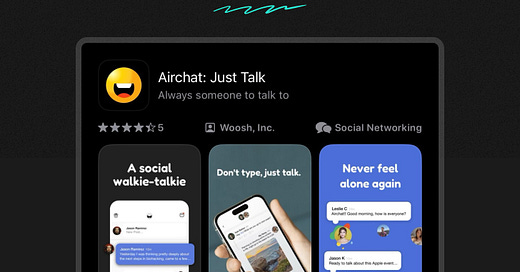24 Hours With Airchat
First impressions of the design dynamics at play with Naval Ravikant's new voice-led social media app.
Welcome to Unknown Arts, where creative builders navigate new possibilities. Ready to explore uncharted territory? Join the journey!
I'm a reluctant adopter of even the most widely used social media platforms, so it was surprising when I got FOMO this week for a new social media app called Airchat.
Airchat describes itself as a "push-to-talk, voice-first group messenger with perfect transcripts." At first glance, that sounds similar to other voice chat apps like Clubhouse. However, Airchat's promotion of voice transcripts as a central feature delivers a unique experience that's worth a closer look, regardless of whether the app surges to dominance or fades into obscurity.
The Surprising Power of Voice-to-Text Transcription
In most voice-led apps, content starts and ends as audio. Users create and consume media in the same format. Airchat plays with this exchange - it uses speech as the input method but transcribes that audio to text. It then puts the text visually front and center and supports it with the recorded audio.
This transformation and shift of focus feels novel and surprising - a ripple in the wave of multimodal media transformation that AI can facilitate. As a creator, you don't need the text because you just speak your ideas. And as a consumer, you don't need the audio because the information is captured in the text. Despite not needing both text and audio at all times, the integration of the two sides gives the experience a distinct flavor.
At the end of the day, a thought is a thought, no matter if it's captured as audio, text, or video. The flexibility in transforming from one medium to another opens interesting new doors for capturing and sharing information online.
Embracing the Authenticity of Imperfect Speech
On Airchat, I have to confront and accept the imperfections of my natural speech. Seeing my words immediately put into text changes my perception of them. The AI transcription fixes minor flaws but my other intermediate thoughts get captured and printed to the timeline. If I don't like the recording, I can do another take, but that's time-consuming.
This dynamic isn't inherently bad, but it is a big change from the curated feeds I'm used to on other social platforms. Airchat promotes letting my natural, imperfect language fly. I won't lie, it's a little nerve-wracking at first. It feels easier when talking to people I know, but tougher when messaging strangers where I'd prefer more formality.
Overall, I like the idea of nudging the culture toward acceptance of natural, imperfect communication. I'm curious to see how this feeling evolves as I continue using the app.
Balancing Efficiency and Expressiveness in Voice vs. Text
While the main Airchat feed appears similar to other social platforms like Twitter or Threads, the average post seems longer and less information-dense, with more filler. This makes sense, as natural speech is often more verbose and roundabout compared to edited writing.
When we speak, we're improvising and figuring out our thoughts on the fly - it's a rough first draft. Capturing those ideas in text allows us to critique and refine them, separating the signal from the noise. Thoughtful writing is therefore generally more efficient for conveying and consuming ideas.
However, some useful data is lost in the process of transforming ideas from audio to text. Compared to audio, the text loses the nuance of tone and inflection. And compared to video, it also loses body language and environmental context. Trading intentional writing for spoken transcription transfers some cognitive load from the idea creator to the consumer. It’s a balancing act - the text contains more extraneous information, but it gains the benefits of audio/visual cues that can enhance connection.
Only time will tell whether the app can strike the right balance.
Navigating Airchat’s Conversational Landscape
Naval uses the metaphor of a "house party in your pocket" to describe the Airchat experience. It's an evocative idea, but also a lot to take in.
Whereas Twitter feels like being dropped into the midst of 100 blog headlines, Airchat feels more like being dropped into the middle of 100 simultaneous conversations. Where do I start? Who do I talk to? Do I just try to drink from the firehose?
When hosting in-person parties, I often do introductions and icebreakers to help people feel comfortable starting and joining new conversations. The Airchat team is already trying to facilitate similar bridging behaviors, like themed rooms, to help new users navigate the experience. It feels likely to me that they’ll need even more of this.
It makes me think Airchat may be more useful as a replacement for something like a WhatsApp community, rather than as a broad Twitter-like distribution tool. The intimate, voice-driven nature of the app seems better suited for smaller, more closely-knit groups than the vast, open-ended feeds of mainstream social media.
How Airchat Can Foster a Welcoming Community
While the amount of information on Airchat can feel overwhelming, the overall vibe of the app is welcoming. I think this is partly due to Airchat's approach to reducing anonymity which gives it a more personal feel.
On Airchat, even if a user has a visual avatar, you'll at least hear their voice. This intimacy, combined with encouraging people to use their real identity, makes it harder for people to act like anonymous forum trolls. Instead, they have to put their actual reputation on the line when they speak. This natural moderation can create a more welcoming environment for everyone.
I hope Airchat continues to lean into reducing anonymity. By encouraging real identities, the team can foster a sense of shared humanity that’s often lacking in social media spaces dominated by faceless avatars and usernames. This could be a key ingredient for differentiating Airchat from the toxicity that plagues many online communities.
A Clear Point of View
Much of the social media landscape has fallen into a spiral where product design choices are led almost entirely by metrics. The prevailing mindset seems to be: "Do whatever the data says." This basically means having no point of view at all.
In contrast, Airchat is not like that. The team has a strong point of view on what they're creating, which is obvious in just a few minutes of browsing their responses to users.
It’s so refreshing.
The world doesn't need another run-of-the-mill social media app. Even if Airchat fails to take hold, it can inspire innovation in the space by taking a clear, opinionated stance.
Final Thoughts
It's too early to make any conclusive statements about Airchat's long-term prospects. But I will say this: the execution so far has already inspired more curiosity than criticism from me. I take that as a good sign.
I wish the Airchat team the best of luck as they push the boundaries to innovate in a tricky space. I admire their willingness to experiment and take risks, and I look forward to seeing how the app evolves.
Until next time,
Patrick
Interested in working together? Check out my portfolio.






